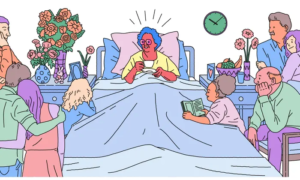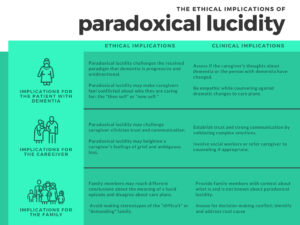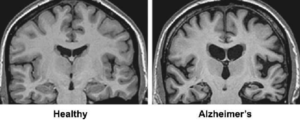The Last Spark: Unveiling the Mysteries of Terminal Lucidity

Written by: Abhinav Anne
Intrigued by the profound contemplations of religion, philosophy, and literature on the conscious experience of dying, science has recently directed substantial attention toward unraveling the mysteries of death. The relentless pursuit of medical advancements, particularly the advent of Cardiopulmonary Resuscitation (CPR) around 1959, marked a transformative moment in the resuscitation of individuals on the brink of death. Critical care physician Sam Parnia, affiliated with NYU Langone Health, clarifies the evolution from cardiac arrest as a synonym for death to a realm where reviving individuals up to 20 minutes post-heart stoppage challenges our understanding of death. Over the past decade, research has unveiled heightened brain activity during cardiac arrest in both human and animal subjects. Recent surveys have revealed unexplained periods of lucidity in dying dementia patients that underscore the active, complex nature of the brain during the dying moments. In this article we’ll be looking into these studies and what they mean in a larger context.
Terminal Lucidity
Contrary to the conventional narrative of cognitive decline in the dying moments, terminal lucidity presents a surprising point of view on individuals nearing death. This phenomenon, characterized by the unexpected return of cognitive faculties such as speech offers a unique glimpse into the intricacies of the dying brain. As Chief Executive Officer at the Center for Hospice and Palliative Care in New York, Christopher Kerr notes, “These episodes typically manifest in the last few days of life, signifying a poignant connection between terminal lucidity and the approach of death”. Andrew Peterson, a researcher of bioethics and consciousness, emphasizes the nature of this connectedness, highlighting the emergence of the “old self”, or the awakening of personalities and characteristics associated with individuals before they had dementia. Research indicates the prevalence of terminal lucidity, in more than just dementia patients. Jason Karlawish, a gerontologist, proposes viewing these episodes as integral to the “disease experience,” occurring not only at the threshold of death but also months or even years before. This frequency of about 20%, prompts a reevaluation of our established idea (Nahm 2012). The potential existence of neural networks and pathways involved in terminal lucidity challenges neuroscientists to delve into the mechanisms to unravel its mysteries. In its early phases, research into this field opens a gateway for scientists and clinicians to gain profound insights occurring in the diseased and dying brain (Figure 1).

Figure 1
An illustration of an individual experiencing terminal lucidity gaining a resurgence of cognitive functions
Source: The Guardian
Exploring Consciousness at Life’s Threshold
The exploration of the conscious experience during the dying process has become a focal point in scientific inquiry. In a recent study published in the Proceedings of the National Academy of Sciences, researchers at the University of Michigan embarked on an exploration of the intricate neural dynamics occurring during the transition from life to death. Building on over a decade of animal research, including studies with rats exposed to cardiac toxins and asphyxiation, the investigation revealed a surge in organized brain activity in two out of four comatose individuals undergoing cardiac arrest after being removed from life support. This surge, characterized by heightened gamma-wave activity, typically associated with wakefulness, alertness, and memory recall, manifested within the initial minutes of cardiac arrest, only to cease thereafter. Neurologist Jimo Borjigin, a key figure in these studies, emphasized the intensity of gamma-wave activity in a specific brain region known as the “posterior cortical ‘hot zone,'” demonstrating an increase in consciousness. Borjigin’s hypothesis revolves around the brain’s attempt to reestablish homeostasis, activating survival mechanisms in response to a sudden reduction in oxygen supply. This intricate dance of neural responses, coupled with the unexpected spike in brain activity observed during CPR, as detailed in the AWARE II study led by Sam Parnia, underscores the brain’s resilience in the face of physiological challenges during dying moments (Nahm 2013). Parnia’s insights into the loss of typical suppression mechanisms of the brain shed light on the lucidity experienced by individuals undergoing cardiac arrest, challenging traditional misconceptions of hallucinations.
Understanding the Unexplained Phenomenon
Dementia, characterized by the progressive loss of memory, cognition, and speech due to brain changes from diseases like Alzheimer’s or Parkinson’s, affects more than 55 million people globally (Figure 2). The journey is often distressing, especially in advanced stages when patients may treat loved ones as strangers, due to memory loss. Amidst this challenging landscape, terminal lucidity acts as a final rally against dementia and allows individuals to suddenly regain mental clarity shortly before death (Lockett 2023). The most dramatic cases involve patients regaining motor function and engaging in meaningful activities, such as having a steak with family, only to peacefully pass away the next day.

Figure 2
Magnetic Resonance Imaging (MRI) sample of a healthy person’s brain (left) and one of an Alzheimer’s patient (right)
Source: ResearchGate
Quest for Knowledge Amid Limited Understanding
Despite its historical documentation, terminal lucidity remains a mysterious and sporadic occurrence, making end-of-life research challenging. Clinical psychologist Douglas Vakoch underscores the ethical dilemmas associated with studying this fleeting phenomenon (Ijaopo 2023). Acknowledging the need for a deeper understanding, the US National Institute on Aging (NIA) initiated a mission in 2018 to unravel the mysteries of “paradoxical lucidity,” an umbrella term encompassing terminal lucidity and other unexpected periods of clarity in dementia patients (Figure 3).

Figure 3
A Diagram examining the Ethical and Clinical implications of paradoxical lucidity
Source: Europe PMC
The NIA’s workshop on paradoxical lucidity brought together experts from neuroscience, geriatrics, and related fields to assess existing knowledge and chart a course for further exploration. Subsequently, the NIA announced funding opportunities to propel rigorous and systematic studies into paradoxical lucidity. Four groups, including the University of Wisconsin-Madison (UWM), have secured funding to delve into defining and measuring the prevalence of this phenomenon.
UWM’s Pioneering Insights
In June 2022, the UWM team revealed their initial findings after interviewing caregivers and clinicians about their experiences with episodes of lucidity in dementia patients. The study emphasized the need for standardization in defining paradoxical lucidity, given the subjective nature of what participants deemed “significant” or “meaningful.” Recognizing the importance of caregiver or clinician accounts, the research highlights the challenge of identifying subtle changes for those not intimately familiar with the patient.
Ongoing Studies and Future Hope
Ongoing NIA-funded studies, such as the EEG-based investigation tracking terminally ill patients, aim to create measurement scales for paradoxical lucidity. By visually, auditorily, and biologically capturing these moments, researchers hope to unravel the brain’s underlying biomarkers. This ambitious endeavor, led by Sam Parnia of NYU Langone, holds the promise of uncovering structural changes that could become novel therapeutic targets. Despite the challenges and ethical considerations, these initiatives represent a significant leap forward in the pursuit of treatments that might temporarily reverse dementia. As Basil Eldadah of NIA notes, “We’ve seen enough examples of this to be reassured that dementia can be reversed… and so the question then is how.”
Conclusion: Unlocking Doors to Reversal
While terminal lucidity’s true nature eludes us, these pioneering studies are unlocking doors to potential breakthroughs in dementia care. By acknowledging the possibility of reversibility, we embark on a journey to comprehend the intricate neural dance occurring in the dying moments of those with severe cognitive disorders. The hope is that, in understanding the unexplained, we may discover avenues for not just providing solace but potentially altering the trajectory of dementia, offering moments of lucidity in the midst of a challenging journey. As research paints an increasingly detailed picture of death as a complex and active process, this exploration of neural dynamics serves as a crucial step toward reversing dementia and understanding the life-death relationship.
References
End-of-Life Rallying: What is Terminal Lucidity? (n.d.). Retrieved from https://www.crossroadshospice.com/hospice-palliative-care-blog/2019/july/16/end-of-life-rallying-what-is-terminal-lucidity/
Ijaopo, E. O., Zaw, K. M., Ijaopo, R. O., & Khawand-Azoulai, M. (2023). A Review of Clinical Signs and Symptoms of Imminent End-of-Life in Individuals With Advanced Illness. Gerontology & geriatric medicine, 9, 23337214231183243. https://doi.org/10.1177/23337214231183243
Kinard, J. (2023). Why Dying People Often Experience a Burst of Lucidity. Retrieved from https://www.scientificamerican.com/article/why-dying-people-often-experience-a-burst-of-lucidity/
Lockett, E. (2023). Terminal Lucidity: What We Know and What We’re Learning. Retrieved from https://www.healthline.com/health/alzheimers-dementia/terminal-lucidity
Nahm, M., & Greyson, B. (2013). The death of Anna Katharina Ehmer: a case study in terminal lucidity. Omega, 68(1), 77–87. https://doi.org/10.2190/om.68.1.e
Nahm, M., Greyson, B., Kelly, E. W., & Haraldsson, E. (2012). Terminal lucidity: a review and a case collection. Archives of gerontology and geriatrics, 55(1), 138–142. https://doi.org/10.1016/j.archger.2011.06.031
Terminal lucidity and dementia: Definition and causes. (n.d.). Retrieved from https://www.medicalnewstoday.com/articles/terminal-lucidity-dementia
3 thoughts on “The Last Spark: Unveiling the Mysteries of Terminal Lucidity”